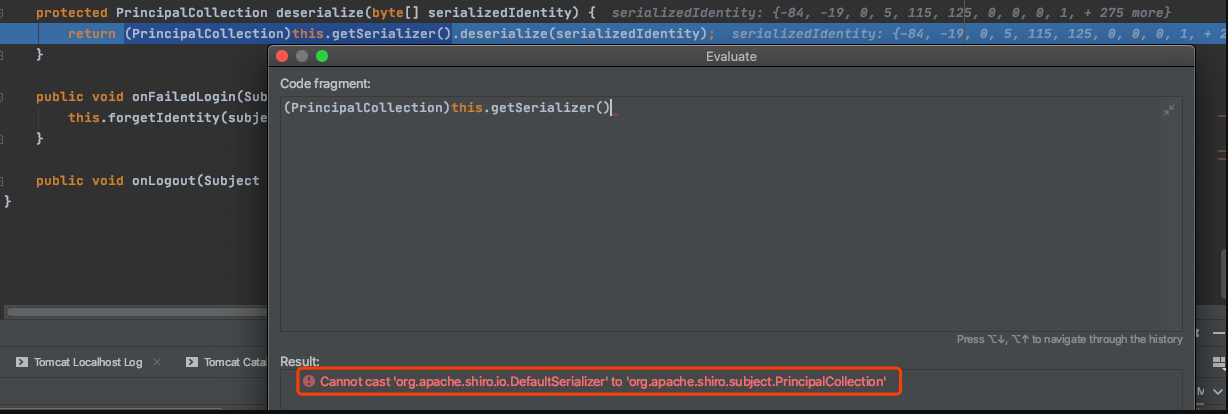问答
发起
提问
文章
攻防
活动
Toggle navigation
首页
(current)
问答
商城
实战攻防技术
漏洞分析与复现
NEW
活动
摸鱼办
搜索
登录
注册
一种另类的shiro检测方式
shiro 这玩意去年出现在大众视野里,众多师傅大喊hvv没有shiro不会玩,实际上追溯这个洞最早开始时候是2016年的事情了,也就是说因为某些攻防演练,这个洞火了起来,当然我也聊一点不一样东西,因为其他东西师傅们都玩出花了。
0x01 前言 ------- shiro 这玩意今年出现在大众视野里,众多师傅大喊hvv没有shiro不会玩,实际上追溯这个洞最早开始时候是2016年的事情了,也就是说因为某些攻防演练,这个洞火了起来,当然我也聊一点不一样东西,因为其他东西师傅们都玩出花了。 0x02 过程 ------- 首先判断 shiro 的 key 这个过程,我之前采用的逻辑就是 YSO 的 URLDNS 针对 dnslog 进行处理,如果没有 dnslog 的情况下,考虑直接用CC盲打,判断延迟。这种会存在一些小问题,比如当这个 shiro 没有 dnslog ,且 gadget 不是CC的情况下,可能就会漏过一些漏洞。 大家判断是否是 shiro 的逻辑,普遍都是在 request 的 cookie 中写入 rememberMe=1 ,然后再来看 response 的 set-cookie 是否出现的 rememberMe=deleteMe 。下文就针对这个 rememberMe=deleteMe 进行深入研究,看看为啥会这样。 网上已经有很多文章,包括我自己树立了一遍 shiro 反序列化的整个过程,这里就不多赘述,核心点在 AbstractRememberMeManager#getRememberedPrincipals 这段代码中。 ```java public PrincipalCollection getRememberedPrincipals(SubjectContext subjectContext) { PrincipalCollection principals = null; try { byte[] bytes = this.getRememberedSerializedIdentity(subjectContext); if (bytes != null && bytes.length > 0) { principals = this.convertBytesToPrincipals(bytes, subjectContext); } } catch (RuntimeException var4) { principals = this.onRememberedPrincipalFailure(var4, subjectContext); } return principals; } ``` 好了,下面我们分别来看两种情况。 1、key不正确的情况 当key错误的时候,我们知道 AbstractRememberMeManager#decrypt 是处理解密的过程。 ```java protected byte[] decrypt(byte[] encrypted) { byte[] serialized = encrypted; CipherService cipherService = this.getCipherService(); if (cipherService != null) { ByteSource byteSource = cipherService.decrypt(encrypted, this.getDecryptionCipherKey()); serialized = byteSource.getBytes(); } return serialized; } ``` 这里代码会进入`cipherService.decrypt(encrypted, this.getDecryptionCipherKey());`进行处理,由于key错误自然是解不出自己想要的内容,所以进入到 `JcaCipherService#crypt(Cipher cipher, byte[] bytes)`这里会抛出异常。 [](https://cdn-yg-zzbm.yun.qianxin.com/attack-forum/2021/04/attach-58128b8bf37135bb6275f1b1b61e912ccf632d24.png) 这里抛出异常之后,自然会进入到我们最开始核心点 AbstractRememberMeManager#getRememberedPrincipals 的 catch 异常捕获的逻辑当中,别急,先慢慢品一下这个。 ```java catch (RuntimeException var4) { principals = this.onRememberedPrincipalFailure(var4, subjectContext); } ``` 跟进去 onRememberedPrincipalFailure 方法,这里代码就4行,不多赘述继续跟进 forgetIdentity 方法。 ```java protected PrincipalCollection onRememberedPrincipalFailure(RuntimeException e, SubjectContext context) { if (log.isDebugEnabled()) { log.debug("There was a failure while trying to retrieve remembered principals. This could be due to a configuration problem or corrupted principals. This could also be due to a recently changed encryption key. The remembered identity will be forgotten and not used for this request.", e); } this.forgetIdentity(context); throw e; } ``` 在 forgetIdentity 方法当中从 subjectContext 对象获取 request 和 response ,继续由`forgetIdentity(HttpServletRequest request, HttpServletResponse response)`这个构造方法处理。 ```java public void forgetIdentity(SubjectContext subjectContext) { if (WebUtils.isHttp(subjectContext)) { HttpServletRequest request = WebUtils.getHttpRequest(subjectContext); HttpServletResponse response = WebUtils.getHttpResponse(subjectContext); forgetIdentity(request, response); } } ``` 跟进forgetIdentity(HttpServletRequest request, HttpServletResponse response),看到一个 removeFrom 方法。 ```java private void forgetIdentity(HttpServletRequest request, HttpServletResponse response) { getCookie().removeFrom(request, response); } ``` 继续跟进 removeFrom 方法,发现了给我们的 Cookie 增加 deleteMe 字段的位置了。 ```java public void removeFrom(HttpServletRequest request, HttpServletResponse response) { String name = getName(); String value = DELETED_COOKIE_VALUE; //deleteMe String comment = null; //don't need to add extra size to the response - comments are irrelevant for deletions String domain = getDomain(); String path = calculatePath(request); int maxAge = 0; //always zero for deletion int version = getVersion(); boolean secure = isSecure(); boolean httpOnly = false; //no need to add the extra text, plus the value 'deleteMe' is not sensitive at all addCookieHeader(response, name, value, comment, domain, path, maxAge, version, secure, httpOnly); ``` 2、反序列化gadget 还有一种情况,大家用反序列化 gadget 生成之后,拿shiro加密算法进行加密,但是最后依然在 response 里面携带了rememberMe=deleteMe。 [](https://cdn-yg-zzbm.yun.qianxin.com/attack-forum/2021/04/attach-3f369cc18f9d0a8f155fde1089f3d3d08ad112ba.png) 这里再来品一下,还是回到 AbstractRememberMeManager#convertBytesToPrincipals 方法当中,这里的key肯定是正确的,所以经过 decrypt 处理之后返回 bytes 数组,进入了 deserialize 方法进行反序列化处理。 ```java protected PrincipalCollection convertBytesToPrincipals(byte[] bytes, SubjectContext subjectContext) { if (this.getCipherService() != null) { bytes = this.decrypt(bytes); } return this.deserialize(bytes); } ``` 跟进 deserialize 方法,下面重点来了。 ```java protected PrincipalCollection deserialize(byte[] serializedIdentity) { return (PrincipalCollection)this.getSerializer().deserialize(serializedIdentity); } ``` 反序列化的 gadget 实际上并不是继承了 PrincipalCollection ,所以这里进行类型转换会报错。 [](https://cdn-yg-zzbm.yun.qianxin.com/attack-forum/2021/04/attach-66594b551be019bb882ce66b1512ca5ac662c97d.png) 但是在做类型转换之前,先进入了 DefaultSerializer#deserialize 进行反序列化处理,等处理结束返回 deserialized 时候,进行类型转换自然又回到了上面提到的类型转换异常,我们 key 不正确的情况下的 catch 异常捕获的逻辑里,后面的流程就和上述一样了。 [](https://cdn-yg-zzbm.yun.qianxin.com/attack-forum/2021/04/attach-a145cff0e89356fbf89031ca256764331e81fd5c.png) 0x03 构造 ------- 那么总结一下上面的两种情况,要想达到只依赖shiro自身进行key检测,只需要满足两点: 1.构造一个继承 PrincipalCollection 的序列化对象。 2.key正确情况下不返回 deleteMe ,key错误情况下返回 deleteMe 。 基于这两个条件下 SimplePrincipalCollection 这个类自然就出现了,这个类可被序列化,继承了 PrincipalCollection 。 [](https://cdn-yg-zzbm.yun.qianxin.com/attack-forum/2021/04/attach-836eaa2d6d4617b52d72a3a064bfe42786d80d7e.png) 构造POC实际上也很简单,构造一个这个空对象也是可以达到效果的。 ```java SimplePrincipalCollection simplePrincipalCollection = new SimplePrincipalCollection(); ObjectOutputStream obj = new ObjectOutputStream(new FileOutputStream("payload")); obj.writeObject(simplePrincipalCollection); obj.close(); ``` key正确: [](https://cdn-yg-zzbm.yun.qianxin.com/attack-forum/2021/04/attach-e1170bfc4ff9492299b4c54e967bcce311512cfc.png) key错误: [](https://cdn-yg-zzbm.yun.qianxin.com/attack-forum/2021/04/attach-134b60123a82595e257596f14a7d043aaff7a271.png) 文章首发与自己博客,原文地址为:<http://www.lmxspace.com/2020/08/24/%E4%B8%80%E7%A7%8D%E5%8F%A6%E7%B1%BB%E7%9A%84shiro%E6%A3%80%E6%B5%8B%E6%96%B9%E5%BC%8F/>
发表于 2021-04-15 17:14:15
阅读 ( 8563 )
分类:
漏洞分析
0 推荐
收藏
0 条评论
请先
登录
后评论
l1nk3r
2 篇文章
×
发送私信
请先
登录
后发送私信
×
举报此文章
垃圾广告信息:
广告、推广、测试等内容
违规内容:
色情、暴力、血腥、敏感信息等内容
不友善内容:
人身攻击、挑衅辱骂、恶意行为
其他原因:
请补充说明
举报原因:
×
如果觉得我的文章对您有用,请随意打赏。你的支持将鼓励我继续创作!